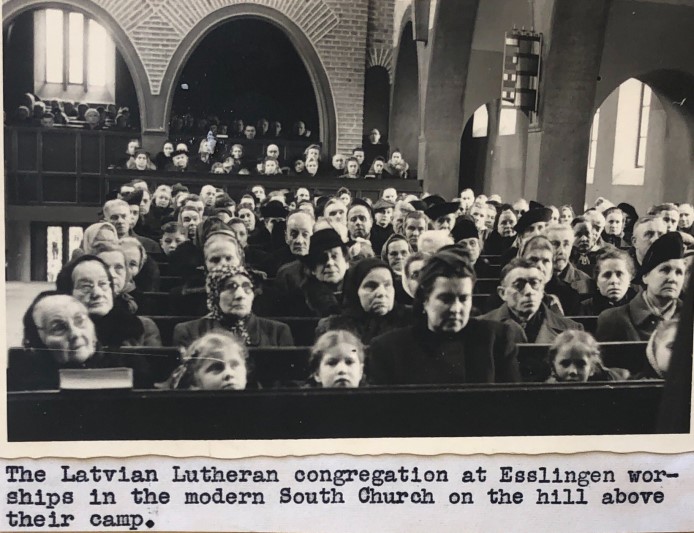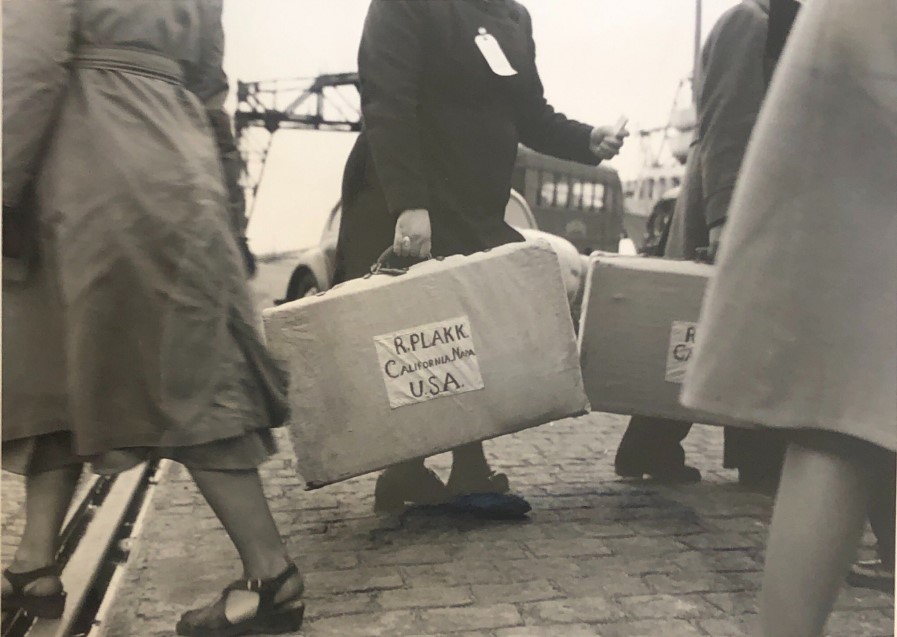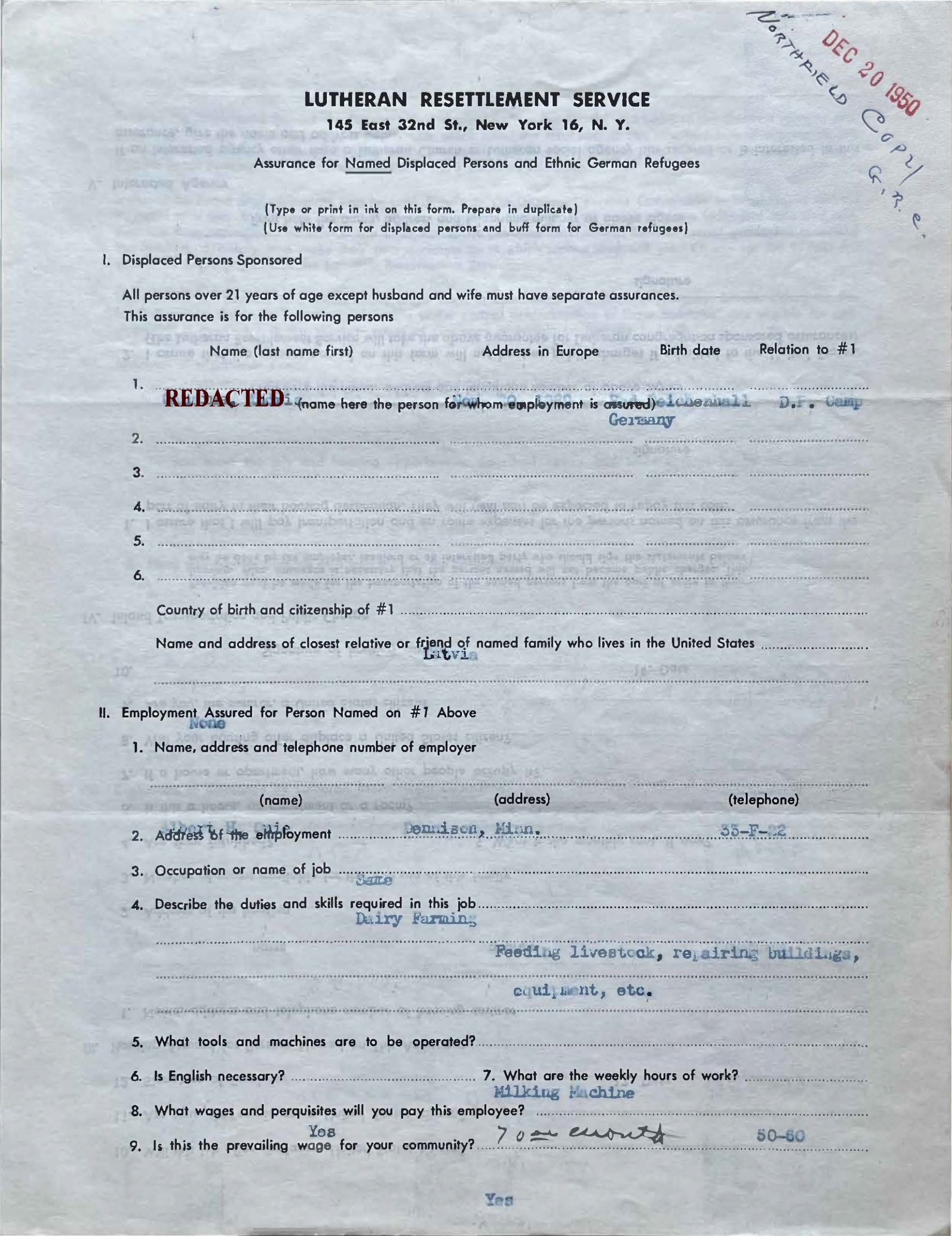Key Terms & Concepts
Displaced Person vs. Refugee
When discussing World War II and aid to refugees, defining what a DP (displaced person) is and what a refugee is key to understanding the history. To summarize the core difference, Kenneth Senft, LWF-SR Area Director of the American Zone, writes:
“Not all refugees are displaced persons, technically speaking, but all displaced persons are refugees.”1
Refugee is the broadest term for those who had to leave their home due to external pressures. In comparison, Displaced Person is a term specific to the post-World War II context. It describes a person who has been a victim of regimes of the time and is under the care of the United Nations.2
The majority of the DPs or refugees in this research’s context tended to be Eastern European. To understand what the terms ‘DP’ or ‘refugee’ meant in their historical, cultural, and political context, visit this article from The National WWII Museum.
Churches in Exile
This term was utilized by the displaced persons themselves as well as by LWF officials to refer to Lutheran groups who fled their home countries following or during World War II. These so-called “Churches in Exile” included Lutherans from Estonia, Latvia, Lithuania, Hungary, Ukraine, and Poland.5
To learn more about the life of Churches in Exile, be sure to visit the Churches in Exile page.
Volksdeutsche/Ethnic Germans
Volksdeutsche or Ethnic Germans included those with German heritage yet were residing outside of Germany such as in Poland and Eastern European countries (ie. Baltics, Romania, and Ukraine). However, this definition is not so simple when looking at the history of WWII. As Doris L. Bergen contends, Volksdeutsche was a term created with the purpose of motivating Nazi movement into Eastern Europe as well as ethnic German participation in anti-Semitism and Nazism. Yet, through intermarrying, speaking different languages, or merely not following Nazi sentiments, not all ethnic Germans fit under this heavily politicized definition.6 Many Volksdeutsche became refugees in Germany and Austria after being expelled from their home countries or forced to flee from the Red Army beginning around the 1940s.7 After expulsions slowed and essentially came to mostly an end in 1949, while not qualified under the IRO definition of a displaced person, ethnic Germans began to find opportunities within or outside of Germany.8
For more information on Volksdeutsche and occupation during and after World War II, be sure to check out the Occupation page under Churches in Exile.
Resettlement
Displaced Persons Acts in the United States
Beginning with the DP Act of 1948, the United States made many and amended policies and amendments surrounding the entry of refugees to the country. Such policies:
-
- Set quotas;
- Defined who the United States would let into the country in and for how long;
- Created certain qualifications for acceptance (assurances)9
For more information on the effects of American DP Acts, visit the US Immigration Policies page.
Assurance:
a promise of a job and a place to stay in America10
Nominated Assurance
an assurance specific to a person or a family; could be connected through agencies like NLC or LWF-SR or done by family members/friends10
Anonymous Assurance
an assurance not specific to a person but for anyone who fits the general requirements
usually LWF-SR would match a family/person with these requirements and then sponsor them12
Sponsor/Sponsee
a person from a receiving country who provides an assurance to their sponsee, a refugee desiring to emigrate13
Organizational Acronyms
For details about the many different organizations how they interacted, visit the International Cooperation page.
Transnational Non-Religious Organizations
United Nations Relief and Rehabilitation Administration (UNRRA), followed up by International Refugee Organization (IRO): Organized in 1943, UNRRA was an international relief agency established by the United Nations that focused on displaced persons after WWII and was the first relief agency that established camps and provided basic needs for the DPs. IRO succeeded UNRRA’s work in 1947, and its responsibilities included: managing the DP camps, cooperating with the voluntary agencies, and resettlement services.
Council of Relief Agencies Licensed to Operate in Germany(CRALOG): Established under the Truman Directive primarily to ship supplies over to Germany, CRALOG was a united body of 15 voluntary agencies licensed to serve in Germany.
Transnational Christian Organizations
Church World Service(CWS): From 1946 to 1948, this Protestant relief agency worked in Germany in child welfare, vocational training, education and personal counseling.
World Council of Churches(WCC): Beginning in 1948, the World Council of Churches is an inter-church organization whose divisions were highly involved in relief alongside Lutheran World Federation Service to Refugees.
Young Men Christian Association(YMCA): YMCA is a worldwide Christian organization that had roots in post-war Germany through its summer camps for children, training programs for youth leadership, and war prisoners’ programs. It also has LWF staff working with them often.
National and Transnational Lutheran Organizations
Lutheran World Federation Service to Refugees(LWF(SR)): Established in Lund in 1947, this international Lutheran organization and its division dedicated to refugee aid (Service to Refugees) is the main focus of this website. LWF-SR primarily worked in spiritual aid (providing religious materials or organizing pastors/congregations) and resettlement work.
National Lutheran Council(NLC): The National Lutheran Council(NLC), formed in 1918, was an American Lutheran organization that primarily worked in publicity, coordination of agencies and activities, and the creation of new agencies to deal with problems aroused by war and other emergency situations in the Lutheran Church.
Lutheran World Action(LWA): Lutheran World Action was an American Lutheran fundraising appeal connected with the National Lutheran Council and Lutheran World Convention. Through different bulletins, films, or radio projects, it helped fund Lutheran relief services.
Lutheran World Relief(LWR): An important companion to LWA, Lutheran World Relief focused its efforts more on material relief, beginning in Germany and Finland but soon expanding to other countries.
Evangelisches Hilfswerk: Established by the bishops of the various Landeskirches of Germany at the bishop’s conference at Treysa in 1945, Evangelisches Hilfwerk was the aid organization of the German Lutheran Church.
Endnotes
- Kenneth C. Senft, “The Lutheran World Federation and the Displaced Person” (PhD diss., Lutheran Theological Seminary, 1952), 1.
- Ibid.
- United Nations, “Constitution of the International Refugee Organization,” December 15, 1946, United Nations, Treaty Series, vol. 18, p. 3, https://treaties.un.org/pages/ViewDetails.aspx?src=IND&mtdsg_no=V-1&chapter=5&clang=_en.
- Ibid.
- Kenneth C. Senft, “The Lutheran World Federation and the Displaced Person” (PhD diss., Lutheran Theological Seminary, 1952); Lutheran World Federation, Lutheran World Federation Service to Refugees in Germany 1947-1949. Materials for Report, vol. 1, ed. Howard Hong (1949).
- Doris L. Bergen, “The Nazi Concept of ‘Volksdeutsche’ and the Exacerbation of Anti-Semitism in Eastern Europe, 1939-45,” Journal of Contemporary History 29, no. 4 (1994): 569–82. http://www.jstor.org/stable/260679.
- Ulrich Merten, Forgotten Voices: The Expulsion of the Germans from Eastern Europe after World War II (New Brunswick, N.J: Transaction Publishers, 2012), 7-20.
- Ibid, 20.
- Haim Genizi, America’s Fair Share: The Admission and Resettlement of Displaced Persons, 1945-1952. (Detroit: Wayne State University Press, 1993), 111; Mark Wyman, DP: Europe’s Displaced Persons, 1945-1951, (Associated University Presses, Inc., 1989), 195.
- Clara Anderson,. “Final Statistics of the DP Program,” letter from Clara Anderson to Dr. Paul Empie, May 21, 1952, Box 8, Folder 20, Paul C. Empie Files, Archives of the Evangelical Lutheran Church in America, Chicago, United States.
- Ibid.
- Ibid.
- Ibid.
Click the button below to view the complete bibliography for this digital exhibition.
Photo Credits (from top to bottom, left to right)*
- Diagram differentiating displaced person and refugee, created by Anneke Shiller using Genially™.
- Group of people sitting in pews, Lutheran World Federation Service to Refugees Photographic Section, used with permission of the Lutheran World Federation and the Evangelical Lutheran Church in America.
- Group of people walking with person holding suitcase, Lutheran World Federation Service to Refugees Photographic Section, used with permission of the Lutheran World Federation and the Evangelical Lutheran Church in America.
- Redacted assurance form from Lutheran Resettlement Service, St. Johns Lutheran Church Archive, Northfield, MN, used with permission of the Evangelical Lutheran Church in America.
*Description ordering is based on computer view. If viewing this page on a smartphone or tablet, please check the descriptions provided as the ordering may be distorted.


